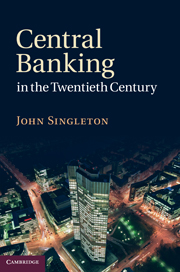Book contents
- Frontmatter
- Contents
- List of illustrations
- Acknowledgements
- List of abbreviations
- 1 A beginner's guide to central banking
- 2 Very boring guys?
- 3 Wind in the willows: the small world of central banking c. 1900
- 4 Something for everyone: new central banks, 1900–1939
- 5 A series of disasters: central banking, 1914–1939
- 6 The mysteries of central bank cooperation
- 7 The first central banking revolution
- 8 No time for cosmic thinkers: Central banking in the ‘Keynesian’ era
- 9 Rekindling central bank cooperation in the Bretton Woods era
- 10 The goose that lays the golden egg: Central banking in developing countries
- 11 The horse of inflation
- 12 The second central banking revolution: Independence and accountability
- 13 Reputations at stake: financial deregulation and instability
- 14 Inflation targeting: the holy grail?
- 15 The long march to European monetary integration
- 16 A world with half a million central bankers
- References
- Index
1 - A beginner's guide to central banking
Published online by Cambridge University Press: 04 February 2011
- Frontmatter
- Contents
- List of illustrations
- Acknowledgements
- List of abbreviations
- 1 A beginner's guide to central banking
- 2 Very boring guys?
- 3 Wind in the willows: the small world of central banking c. 1900
- 4 Something for everyone: new central banks, 1900–1939
- 5 A series of disasters: central banking, 1914–1939
- 6 The mysteries of central bank cooperation
- 7 The first central banking revolution
- 8 No time for cosmic thinkers: Central banking in the ‘Keynesian’ era
- 9 Rekindling central bank cooperation in the Bretton Woods era
- 10 The goose that lays the golden egg: Central banking in developing countries
- 11 The horse of inflation
- 12 The second central banking revolution: Independence and accountability
- 13 Reputations at stake: financial deregulation and instability
- 14 Inflation targeting: the holy grail?
- 15 The long march to European monetary integration
- 16 A world with half a million central bankers
- References
- Index
Summary
When I went to Washington in 1979, most people thought the Federal Reserve was either a bonded bourbon or a branch of the National Guard.
Frederick H. Schultz, Vice-Chairman of the Board of Governors of the Federal Reserve System, 1979–82 (Schultz 2005: 343)Central banking is a strange profession little understood by members of the public whose interests it exists to protect, by governments with which it shares responsibilities, or by financial institutions whose activities it to some degree controls. Those who practise it often feel themselves to be members of an international freemasonry, a kind of ‘mystery’ in the medieval sense of a group who possess some exclusive knowledge or skill, and indeed there has always been an element of mystery … about what central bankers do.
H. C. (Nugget) Coombs, Governor of the Australian Central Bank 1949–68 (Coombs, H. C. 1981: 141)Most central banks nowadays claim to abide by the principle of transparency, yet the world of central banking retains an element of inscrutability. This partly reflects the nature of the subject. Central banking is a weightier and more technical business than chicken farming or running a bus company. Though central banking might not be as delicate as brain surgery, or as complicated as the exploration of space, it is evidently a highly skilled trade. Until transparency became fashionable in the late twentieth century, central bankers did little to promote a wider understanding of their role. Shunning the limelight, their rare public statements were notable for brevity and calculated vagueness.
- Type
- Chapter
- Information
- Central Banking in the Twentieth Century , pp. 1 - 16Publisher: Cambridge University PressPrint publication year: 2010



